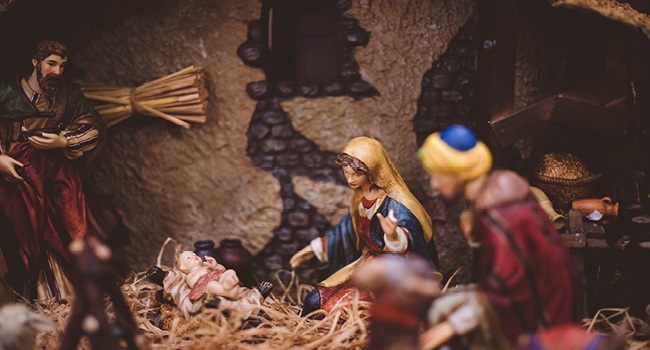
Advent
In western churches the four Sundays prior to Christmas were called Advent, coming from the Latin verb advenire, meaning, “to come towards.”
Prior to December 25th, the church was in a period of penance, preparation, and anticipation of the Messiah’s birth. Fasting was observed several times a week. All of the hymns and prayers reflected this repentance and preparation; a period of darkness into which the Lumen Christi(the light of Christ) must come.
Old Testament prophecies about the Messiah and Gospel passages about the ministry of John the Baptist preparing the way for Christ were read to match the season. Hymns included, On Jordan’s Bank the Baptist’s Cry and O Come Immanuel. But never a Christmas Carol, as Christ had not yet arrived!
Then Cometh Christ’s Mass
For centuries, Midnight Mass on Christmas Eve was a radical change from the previous four weeks — this liturgical text became the centerpiece of a number of Baroque and classical compositions.
Christmas itself means “Christ’s Mass” – the Mass celebrated on Christmas Day. The church was decorated and ablaze with lights. Colors had shifted from purple to gold and white and traditional green/red themes. There was a profusion of incense. Christ had finally come! This was a time of great celebration, hence the use of the word “Feast” to designate the day.
Other Christmas Traditions
The Middle Ages saw the beginnings of liturgical dramas (often called “mystery plays”) designed to portray Biblical stories surrounding Christmas. The majority of the population of Europe at the time was illiterate, so the mystery plays were a form of Biblical immersion. Over the centuries, mystery dramas became profane and secular in nature and performances in churches were eventually banned.
Manger scenes (crèches in French) began to appear, and it was a Christmas custom for every family to visit a church crèche.
The Advent Wreath
Advent wreath customs evolved in northern Europe. The wreath has four candles: three purple and one pink (and a few other particular variations).
One candle is lit on each Sunday of Advent at dinner as those gathered sing, O Come Immanuel.
The third Sunday of Advent is a different color, signifying that while we are still in darkness, there is hope and the light of Christ is coming. In the western church this was called GaudateSunday, meaning we should rejoice, for there is hope.
In America, the tradition started of adding a white candle to the center on Christmas Day to signify that the light of Christ has come into the world.
The Twelve Days of Christmas
The Twelve Days of Christmas ranks as part of a traditional Christmas Carol playlist. So what are they?
These are the days when Christmas was traditionally observed, between December 25th and January 6th. January 6th was the Feast of the Epiphany when the Wise Men arrived 12 days following.
In some cultures presents were given each day of the twelve days instead of tearing through a big wallop of presents on December 25th. Traditionally the Christmas tree went up on December 24th in the evening and came down on January 6th.
The Feast of the Holy Innocents is celebrated on December 28th, commemorating the children who were killed in Bethlehem as Herod sought to destroy the child Jesus.
Enjoy a traditional Christmas at St. Michael’s, in celebration of Christ’s birth!
Christmas Family Mass with Pageant – 4:30 pm
Music Prelude – 10:30 pm
Christmas Eve Candlelit Mass – 11:00 pm
Christmas Day Mass – 10:00 am
Written by parishioner Russ Hollingsworth.
